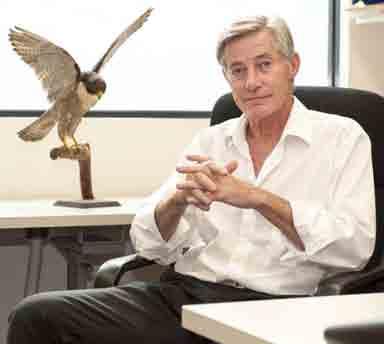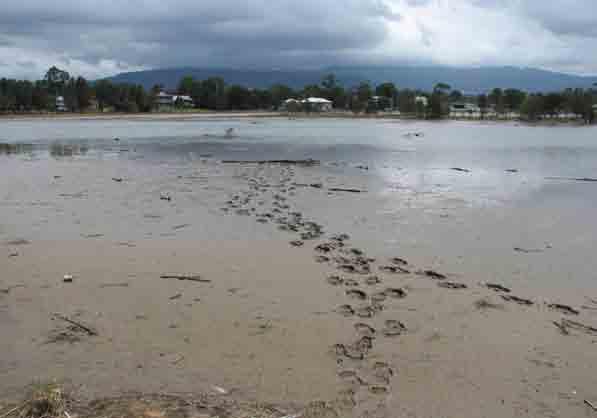
8 minute read
On the road to Yuendumu Revisiting the roots of Aboriginal art
MUSEUM NATURAL HISTORY COLLECTIONS CAN HELP ANSWER MANY QUESTIONS, BUT HOW DO WE ENSURE THEY CONTINUE TO BE RELEVANT, ASKS THE MUSEUM’S DR BRIAN LASSIG.
collections
Opposite
Dr Brian Lassig with Peregrine Falcon, Falco peregrinus. Photo by Stuart Humphreys.
MATTER!
In answering questions about the natural world, scientists often turn to the collections held in natural history museums like ours. Indeed, that’s why we collect specimens in the first place. One well-known example is the study of the bird egg collection at the Field Museum in Chicago in the 1960s which determined that shells of Peregrine Falcon, Falco peregrinus, eggs had become thinner and more fragile since the introduction of DDT for agricultural use. Subsequent work showed that DDT interferes with calcium production in female birds causing them to lay thinshelled eggs which were more likely to be crushed during incubation. With levels of DDT bioaccumulating in the food chain, it was top predators like the peregrine that were being most affected. The study helped us understand why populations of this magnificent bird had declined so drastically, and it resulted in the US government banning the use of DDT for agricultural purposes in 1972. It is crucial to note though that the Field Museum’s collections were made over many decades without this specific question in mind; yet without such a long time-series of collected specimens the reason for the peregrine’s decline might not have been discovered in time.
QUESTIONS
There are many such uses of collections and collection data. To give some idea of the scope and depth of these applications, we can analyse downloads of nearly 750 million records from the Atlas of Living Australia (the shared repository of collection data from many Australian natural history museums). The broad categories of these uses include not only scientific research and education, but many applied uses such as conservation management and planning, environmental impact assessment and biosecurity management. It is reassuring that some decision-making appears to be based on the available scientific information, but the analysis is not all that helpful in understanding exactly what users are trying to discover. Perhaps the most pressing question we’ve been asked recently is: what can our collections tell us about the impact of climate change? The question coincided with the release of the Intergovernmental Panel on Climate Change (IPCC) 5th Assessment Report into the physical science behind climate change. The IPCC report identifies a number of significant and disturbing environmental changes over the last 100 years or so (see panel, opposite). Surely the magnitude of these changes should be forcing radical changes to our biodiversity – but is there any evidence?
ANSWERS
To answer that question, the Australian Museum Research Institute (AMRI) recently hosted a seminar to find out what museum collections can reveal about climate change. We now know, from a study of over 300 species, that the ranges of marine and intertidal molluscs (essentially snails) have been shifting south along the east coast of Australia on average by about 10 kilometres each decade as water temperatures have increased. Some species have shifted at 10 times that rate.
One mussel species studied now has a much narrower range and is likely to be lost from New South Wales if trends continue. Also, the body size of marine snails has decreased over time, probably as a result of increasing acidification of the ocean. Species that have only ever been recorded around mainland Australia have started appearing in Tasmania – even the Blue Groper, the NSW fish emblem, whose southern-most distribution was previously recorded as at Wilson’s Promontory in Victoria. On land, species living in the cooler montane areas are at grave risk as temperatures rise and the available area of suitable habitat shrinks.
A guest speaker at the AMRI seminar, Professor Craig Moritz from the Australian National University, presented a fascinating case study that highlighted the value of planning for future needs. In the early twentieth century, Joseph Grinnell, founding Director of the Museum of Vertebrate Zoology at the University of California, documented and collected vertebrates from more than 700 locations across California and adjoining states. Scientists re-surveyed Grinnell’s sites just a couple of years ago and found a range of climate change impacts among mammals. For example, formerly low-elevation species had expanded their ranges and highelevation species had contracted theirs, leading to changes in the composition of ecological communities at mid- and high elevations.
Such is the power of systematic and strategic collecting.
COLLECTING FOR THE FUTURE
The Australian Museum’s collections date back to 1828 and include many different animal groups, from worms to wallabies. But, like the Field Museum, our collections were not accumulated to answer questions about climate change. There are often big gaps in the time series of collected specimens; collections from single localities are generally not repeated over time; species absent from particular places are usually not recorded; and those species that are collected may not be strongly influenced by the local climate. It is clear that museums should be developing long-term collection programs so that we can more confidently respond to these sorts of questions in the future. So now we have a new challenge: while continuing to document the breadth of Australian biodiversity we need to review how we go about collecting. We need to ensure that we have adequate baseline information so we can be prepared to answer different questions about biodiversity, some of which we know about and others that we can’t even begin to guess!
DR BRIAN LASSIG, ASSISTANT DIRECTOR, SCIENCE AND LEARNING DIVISION, AND HEAD, AUSTRALIAN MUSEUM RESEARCH INSTITUTE
WEBLINK
Find out more about this topic at australianmuseum. net.au/blogpost/collections-climate
THE WARMING PLANET
• Each of the last three decades has been successively warmer at the Earth’s surface than in any preceding decade since 1850.
• Average global land and ocean surface temperatures have warmed by around 0.85 degrees Celsius since 1880.
• Global average sea levels have risen by 0.19 metres over the twentieth century.
• Atmospheric concentrations of carbon dioxide, methane and nitrous oxide have increased to levels unprecedented in at least the last 800,000 years.
• The oceans have absorbed about 30 per cent of the emitted anthropogenic carbon dioxide, causing them to become more acidic.
Source: IPCC 5th Assessment Report
Further reading IPCC, 2013. Climate change 2013: the physical science basis. 5th Assessment Report. World Meteorological Organization, Geneva, Switzerland. ipcc.ch/report/ ar5/wg1/
stealth

INVADERS
DETECTING A BIOLOGICAL INVASION IS MADE ALL THE HARDER IF THE INVADER LOOKS EXACTLY LIKE ONE OF THE LOCALS, REPORTS DON COLGAN.
Above
Looking west across Koona Bay, Lake Illawarra, towards Albion Park. Photo by Don Colgan.
Inset
An overturned log reveals Xenostrobus mussels in their habitat. Every organism is constrained to live within the ecological limits of its environment and biology. Temperature, food sources, predators and other habitat characteristics all help to determine what survives and what does not.
But the balance is easily upset. As constraints change, so does the distribution of species. Generally, as the climate warms, many species’ ranges will tend to move pole-wards. Warm-loving animals creep into areas previously too cold for them. ‘Cool’ species seek out cooler climes, with many montane species facing extinction as their cool mountain-top habitat disappears, leaving them with nowhere to go. In contrast to such gradual changes, species introduced to new areas, accidentally or deliberately, can result in biological invasions on a large scale. Freed from the ecological controls of their native habitat, the population can increase rapidly, often at the expense of the new environment and its inhabitants.
MUSSELLING IN
One such invader is the Zebra Mussel, Dreissena polymorpha, which causes more than US$200 million damage annually by biofouling (growing on boat hulls and other submerged structures) in the Great Lakes region of North America.
Right
These Xenostrobus securis shells (valves) show little or no difference between the non-invasive group (upper two photos) and invasive group (lower two). The scale bars are 5 mm in each photo. Photos by Sue Lindsay. Another troublesome mussel is the little Black Horse Mussel, Xenostrobus securis, which has invaded Japan, the Atlantic coasts of southern Europe and the Mediterranean. In New South Wales, it is one of the most common shellfish living on solid substrates in estuaries and coastal lagoons. Detecting invasive species before they become established is difficult, however, and even more so when the invader has a similar appearance to local species. The original population of X. securis discovered in Japan was thought to be a subspecies of a local mussel and could only be identified as securis by genetic studies. In Australia X. securis has a very broad, supposedly native, distribution, ranging from southern Western Australia to northern Queensland along the southern coasts; the populations in New Zealand are also thought to be native to that country.
IT’S COMPLICATED
Studies of this mussel’s DNA by Australian Museum researchers have found that X. securis may include multiple species that all look much the same. It could actually be a species complex, with the invader effectively slipping into the local populations by stealth. The genetic variants discovered in central NSW populations can be divided into two distinct groups according to how closely they are related. Variants from only one of these groups have been recorded from Japan or Europe. The other group has not yet been discovered outside New South Wales.
Both groups are found in most localities in the state, but the first variant is more frequent in the upper reaches of estuaries, while the second (non-invading) group is more frequent nearer the ocean.
IMPERATIVES
We’re collaborating with interstate and international colleagues in the search for answers to questions like: is the first group truly a separate species? Is it a native or an invader? If an invader, what is its source?
One of the imperatives of this research is that certain European populations of X. securis are known to host a species related to the single-celled parasite that causes QX disease, which can devastate populations of the widely cultivated Sydney Rock Oyster, Saccostrea glomerata. Does the introduced X. securis act as an alternative host of QX disease here? The answer is crucial for understanding this disease and developing solutions for the future management of an industry valued at over $35 million annually.
DR DON COLGAN, PRINCIPAL RESEARCH SCIENTIST








